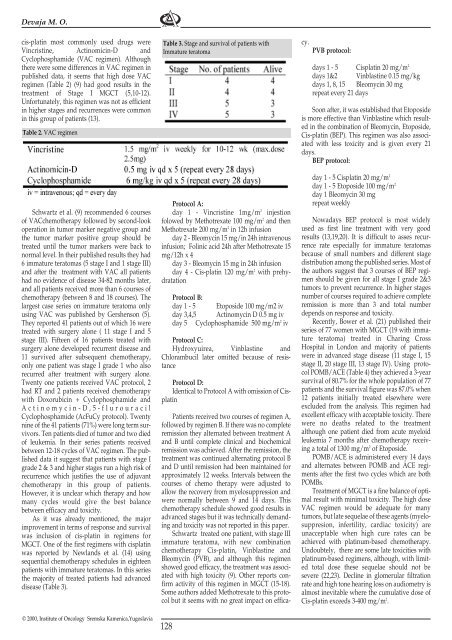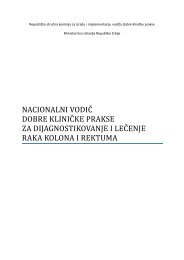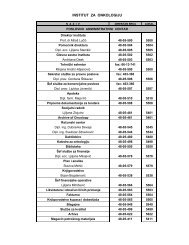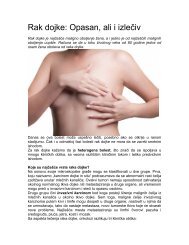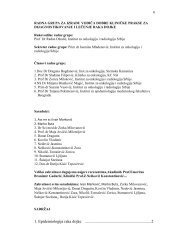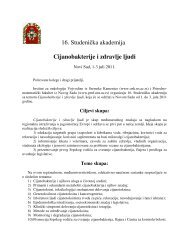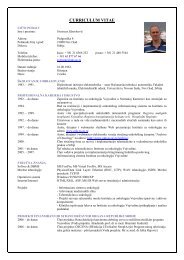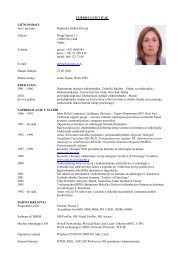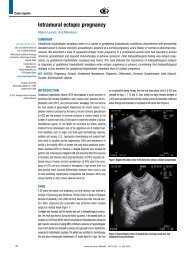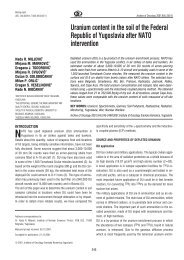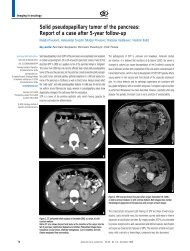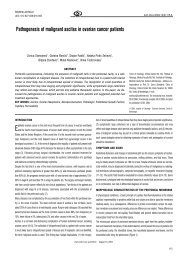Current management of immature teratoma of the ovary
Current management of immature teratoma of the ovary
Current management of immature teratoma of the ovary
You also want an ePaper? Increase the reach of your titles
YUMPU automatically turns print PDFs into web optimized ePapers that Google loves.
Devaja M. O.<br />
cis-platin most commonly used drugs were<br />
Vincristine, Actinomicin-D and<br />
Cyclophosphamide (VAC regimen). Although<br />
<strong>the</strong>re were some differences in VAC regimen in<br />
published data, it seems that high dose VAC<br />
regimen (Table 2) (9) had good results in <strong>the</strong><br />
treatment <strong>of</strong> Stage I MGCT (5,10-12).<br />
Unfortunately, this regimen was not as efficient<br />
in higher stages and recurrences were common<br />
in this group <strong>of</strong> patients (13).<br />
Table 2. VAC regimen<br />
Schwartz et al. (9) recommended 6 courses<br />
<strong>of</strong> VACchemo<strong>the</strong>rapy followed by second-look<br />
operation in tumor marker negative group and<br />
<strong>the</strong> tumor marker positive group should be<br />
treated until <strong>the</strong> tumor markers were back to<br />
normal level. In <strong>the</strong>ir published results <strong>the</strong>y had<br />
6 <strong>immature</strong> <strong>teratoma</strong>s (5 stage I and 1 stage III)<br />
and after <strong>the</strong> treatment with VAC all patients<br />
had no evidence <strong>of</strong> disease 34-82 months later,<br />
and all patients received more than 6 courses <strong>of</strong><br />
chemo<strong>the</strong>rapy (between 8 and 18 courses). The<br />
largest case series on <strong>immature</strong> <strong>teratoma</strong> only<br />
using VAC was published by Gershenson (5).<br />
They reported 41 patients out <strong>of</strong> which 16 were<br />
treated with surgery alone ( 11 stage I and 5<br />
stage III). Fifteen <strong>of</strong> 16 patients treated with<br />
surgery alone developed recurrent disease and<br />
11 survived after subsequent chemo<strong>the</strong>rapy,<br />
only one patient was stage I grade 1 who also<br />
recurred after treatment with surgery alone.<br />
Twenty one patients received VAC protocol, 2<br />
had RT and 2 patients received chemo<strong>the</strong>rapy<br />
with Doxorubicin + Cyclophosphamide and<br />
Actinomycin-D,5-flurouracil<br />
Cyclophosphamide (AcFuCy protocol). Twenty<br />
nine <strong>of</strong> <strong>the</strong> 41 patients (71%) were long term survivors.<br />
Ten patients died <strong>of</strong> tumor and two died<br />
<strong>of</strong> leukemia. In <strong>the</strong>ir series patients received<br />
between 12-18 cycles <strong>of</strong> VAC regimen. The published<br />
data it suggest that patients with stage I<br />
grade 2 & 3 and higher stages run a high risk <strong>of</strong><br />
recurrence which justifies <strong>the</strong> use <strong>of</strong> adjuvant<br />
chemo<strong>the</strong>rapy in this group <strong>of</strong> patients.<br />
However, it is unclear which <strong>the</strong>rapy and how<br />
many cycles would give <strong>the</strong> best balance<br />
between efficacy and toxicity.<br />
As it was already mentioned, <strong>the</strong> major<br />
improvement in terms <strong>of</strong> response and survival<br />
was inclusion <strong>of</strong> cis-platin in regimens for<br />
MGCT. One <strong>of</strong> <strong>the</strong> first regimens with cisplatin<br />
was reported by Newlands et al. (14) using<br />
sequential chemo<strong>the</strong>rapy schedules in eighteen<br />
patients with <strong>immature</strong> <strong>teratoma</strong>s. In this series<br />
<strong>the</strong> majority <strong>of</strong> treated patients had advanced<br />
disease (Table 3).<br />
Ç 2000, Institute <strong>of</strong> Oncology Sremska Kamenica,Yugoslavia<br />
Table 3. Stage and survival <strong>of</strong> patients with<br />
Immature <strong>teratoma</strong><br />
Protocol A:<br />
day 1 - Vincristine 1mg/m 2 injestion<br />
folowed by Methotrexate 100 mg/m 2 and <strong>the</strong>n<br />
Methotrexate 200 mg/m 2 in 12h infusion<br />
day 2 - Bleomycin 15 mg/in 24h intravenous<br />
infusion; Folinic acid 24h after Methotrexate 15<br />
mg/12h x 4<br />
day 3 - Bleomycin 15 mg in 24h infusion<br />
day 4 - Cis-platin 120 mg/m 2 with prehydratation<br />
Protocol B:<br />
day 1 - 5 Etoposide 100 mg/m2 iv<br />
day 3,4,5 Actinomycin D 0.5 mg iv<br />
day 5 Cyclophosphamide 500 mg/m 2 iv<br />
Protocol C:<br />
Hydroxyuirea, Vinblastine and<br />
Chlorambucil later omitted because <strong>of</strong> resistance<br />
Protocol D:<br />
Identical to Protocol A with omission <strong>of</strong> Cisplatin<br />
128<br />
Patients received two courses <strong>of</strong> regimen A,<br />
followed by regimen B. If <strong>the</strong>re was no complete<br />
remission <strong>the</strong>y alternated between treatment A<br />
and B until complete clinical and biochemical<br />
remission was achieved. After <strong>the</strong> remission, <strong>the</strong><br />
treatment was continued alternating protocol B<br />
and D until remission had been maintained for<br />
approximately 12 weeks. Intervals between <strong>the</strong><br />
courses <strong>of</strong> chemo <strong>the</strong>rapy were adjusted to<br />
allow <strong>the</strong> recovery from myelosuppression and<br />
were normally between 9 and 14 days. This<br />
chemo<strong>the</strong>rapy schedule showed good results in<br />
advanced stages but it was technically demanding<br />
and toxicity was not reported in this paper.<br />
Schwartz treated one patient, with stage III<br />
<strong>immature</strong> <strong>teratoma</strong>, with new combination<br />
chemo<strong>the</strong>rapy Cis-platin, Vinblastine and<br />
Bleomycin (PVB), and although this regimen<br />
showed good efficacy, <strong>the</strong> treatment was associated<br />
with high toxicity (9). O<strong>the</strong>r reports confirm<br />
activity <strong>of</strong> this regimen in MGCT (15-18).<br />
Some authors added Methotrexate to this protocol<br />
but it seems with no great impact on efficacy.<br />
PVB protocol:<br />
days 1 - 5 Cisplatin 20 mg/m 2<br />
days 1&2 Vinblastine 0.15 mg/kg<br />
days 1, 8, 15 Bleomycin 30 mg<br />
repeat every 21 days<br />
Soon after, it was established that Etoposide<br />
is more effective than Vinblastine which resulted<br />
in <strong>the</strong> combination <strong>of</strong> Bleomycin, Etoposide,<br />
Cis-platin (BEP). This regimen was also associated<br />
with less toxicity and is given every 21<br />
days.<br />
BEP protocol:<br />
day 1 - 5 Cisplatin 20 mg/m 2<br />
day 1 - 5 Etoposide 100 mg/m 2<br />
day 1 Bleomycin 30 mg<br />
repeat weekly<br />
Nowadays BEP protocol is most widely<br />
used as first line treatment with very good<br />
results (13,19,20). It is difficult to asses recurrence<br />
rate especially for <strong>immature</strong> <strong>teratoma</strong>s<br />
because <strong>of</strong> small numbers and different stage<br />
distribution among <strong>the</strong> published series. Most <strong>of</strong><br />
<strong>the</strong> authors suggest that 3 courses <strong>of</strong> BEP regimen<br />
should be given for all stage I grade 2&3<br />
tumors to prevent recurrence. In higher stages<br />
number <strong>of</strong> courses required to achieve complete<br />
remission is more than 3 and total number<br />
depends on response and toxicity.<br />
Recently, Bower et al. (21) published <strong>the</strong>ir<br />
series <strong>of</strong> 77 women with MGCT (19 with <strong>immature</strong><br />
<strong>teratoma</strong>) treated in Charing Cross<br />
Hospital in London and majority <strong>of</strong> patients<br />
were in advanced stage disease (11 stage I, 15<br />
stage II, 20 stage III, 13 stage IV). Using protocol<br />
POMB/ACE (Table 4) <strong>the</strong>y achieved a 3-year<br />
survival <strong>of</strong> 80.7% for <strong>the</strong> whole population <strong>of</strong> 77<br />
patients and <strong>the</strong> survival figure was 87.0% when<br />
12 patients initially treated elsewhere were<br />
excluded from <strong>the</strong> analysis. This regimen had<br />
excellent efficacy with acceptable toxicity. There<br />
were no deaths related to <strong>the</strong> treatment<br />
although one patient died from acute myeloid<br />
leukemia 7 months after chemo<strong>the</strong>rapy receiving<br />
a total <strong>of</strong> 1300 mg/m 2 <strong>of</strong> Etoposide.<br />
POMB/ACE is administered every 14 days<br />
and alternates between POMB and ACE regiments<br />
after <strong>the</strong> first two cycles which are both<br />
POMBs.<br />
Treatment <strong>of</strong> MGCT is a fine balance <strong>of</strong> optimal<br />
result with minimal toxicity. The high dose<br />
VAC regimen would be adequate for many<br />
tumors, but late sequelae <strong>of</strong> <strong>the</strong>se agents (myelosuppresion,<br />
infertility, cardiac toxicity) are<br />
unacceptable when high cure rates can be<br />
achieved with platinum-based chemo<strong>the</strong>rapy.<br />
Undoubtely, <strong>the</strong>re are some late toxicities with<br />
platinum-based regimens, although, with limited<br />
total dose <strong>the</strong>se sequelae should not be<br />
severe (22,23). Decline in glomerular filtration<br />
rate and high tone hearing loss on audiometry is<br />
almost inevitable where <strong>the</strong> cumulative dose <strong>of</strong><br />
Cis-platin exceeds 3-400 mg/m 2 .


